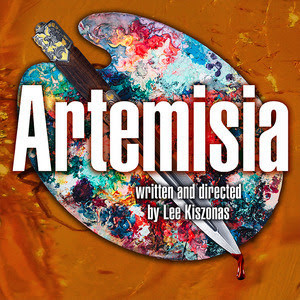 South Camden Theatre Company's
South Camden Theatre Company's
Artistic Director, Raymond Croce, Sr. announces the world premiere production of Philadelphia playwright, Lee Kiszonas's work ARTEMISIA. A celebration of art, women in art, and a lesson that history is bound to repeat itself.
"We are super excited to continue our season, Celebrating Female Playwrights with our friend, Lee Kiszona's play Artemisia", states Ray Croce. "Lee has acted and directed here at South Camden Theatre Company over the past years. To be able to celebrate her work on our stage, is a powerful statement to the celebration of women in theatre here at SCTC."
This new production has been workshopped and is currently in rehearsal under the direction of Lee Kiszonas, the playwright. The highly talented cast includes Nicole Henderson as Artemisia, along with actors
Mariel Rosati, Dam Vernon, Aaron Roberge,
Sheila Walker Kurilla and McKenzie Jones.
According to the playwright, "Artemisia Gentileschi (Rome, 1593-1656) changed the history of art for women yet is widely unknown outside (and even inside) the art community. Her experiments with the color palette created Gentileschi amber and developed new ways to color and fix paintings. She was the first woman to be allowed to attend art school, become a sponsored artist of Cosimo DeMedici, paint scenes of Biblical violence, and try a man for rape."
"She also faced the same struggles that women artists face today. She fought against sexism and sexual aggression, plagiarism, and repression. Her paintings reflect her violent struggle against her time."
"Artemisia is a wild ride of fact and fantasy that takes the audience through the canals, cathedrals, and studios of Venice with malingering artists, murderous courtesans, and malicious barmaids. This piece is a celebration of art, women in art, and a lesson that history is bound to repeat itself."
"Our 2018 Season, chosen by Ray Croce, with the theme of Celebrating Female Playwrights has gotten off to a great start. Audiences were thrilled with our first production, "The Savannah Sipping Society" and they are looking forward to this world premiere," states Robert Bingaman SCTC Board President.
ABOUT THE ARTIST, ARTEMISIA GENTILESCHI:
Artemisia Gentileschi (1593-1656) was a female, Italian painter during Renaissance times. Her father, Orazio Gentileschi, had three children, Artemisia and her two brothers. Her father was a Tuscan painter and he introduced her to painting. Artemisia was not originally allowed to go to an all-male art school so her father hired a private tutor, Agostino Tassi. Early in her career, Artemisia created a painting of a young woman being raped by two elders, this painting was titled "Susanna". Shortly after the painting was finished Artemisia was raped by Tassi. He also attempted to steal paintings from Artemisia and her father.
Artemisia's dealings with Tassi produced the strong feminist view you see in her paintings. It was arranged for Artemisia to marry Pierantonio Stiattesi to restore her honor. Pierantonio was a modest artist from Florence. Soon after the wedding they moved to Florence. While in Florence Artemisia was given a chance to paint at the Casa Buonarroti. She became a very successful court painter, and received the patronage of the Medici family and Charles I.
In Florence, Artemisia had five children, four sons and one daughter. Only the daughter lived to adulthood. Artemisia moved to Naples, at a time when the city was rich with workshops and art lovers. Artemisia stayed there for the rest of the time that she continued to paint. She then met her father in London where he died. Artemisia continued his work by fulfilling commissions after his death. She left England just as the civil war began and went back to Naples. It was in Naples where she is believed to have died in 1656 where the plague had killed almost an entire generation of Neapolitan artists.
Comments
To post a comment, you must
register and
login.
![]() South Camden Theatre Company's
South Camden Theatre Company's
